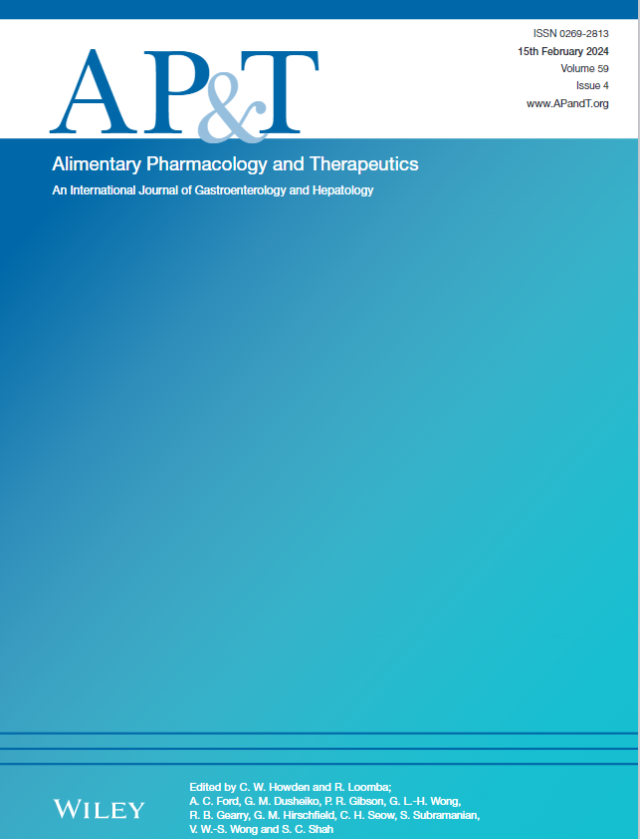MetALD:非侵入性检查的诊断和预后。
IF 6.7
1区 医学
Q1 GASTROENTEROLOGY & HEPATOLOGY
引用次数: 0
摘要
背景:非侵入性检查(nit)是诊断和分层脂肪变性肝病(SLD)风险的核心。然而,目前尚不清楚指南推荐的NIT临界值是否适用于代谢性和酒精相关性肝病(MetALD)。目的评价5种nit在MetALD患者中的诊断和预后表现。方法对423例SLD患者进行单中心研究,其中102例(24%)患有MetALD。根据组织学或控制衰减参数定义的肝脂肪变性和自我报告的酒精摄入量对患者进行分类。我们评估了循环标志物FIB-4、肝脏风险评分、ELF和ADAPT以及瞬态弹性成像(TE),采用确定的晚期纤维化(≥F3)临界值。以肝脏组织学为参照。肝失代偿和全因死亡率的预后评估中位随访时间为62个月。结果在MetALD的循环NITs中,ELF和ADAPT的诊断准确率最高(AUROC = 0.90),而肝脏风险评分的诊断准确率最低(AUROC = 0.74)。FIB-4的排除和纳入临界值之间的不确定区域最大(34%)。TE和循环NIT的一致性在肝脏风险评分中最高(81%),以排除≥F3,而在ELF中最高(88%),以排除≥F3。所有纳入的NITs预测无失代偿生存,并有相应的排除或排除截止。顺序2层检测策略(FIB-4→TE)有效分层失代偿风险。在TE前合并第二级测试(ELF或ADAPT)可使TE转诊的数量分别减少43%和45%,且不影响预后。结论广泛使用的nit可用于MetALD,其中截止值可用于诊断晚期纤维化并预测临床结果。本文章由计算机程序翻译,如有差异,请以英文原文为准。
MetALD: Diagnosis and Prognosis With Non-Invasive Tests.
BACKGROUND
Non-invasive tests (NITs) are central to diagnosing and stratifying risk in steatotic liver disease (SLD). However, it remains unclear whether guideline-recommended NIT cut-offs apply to metabolic and alcohol-related liver disease (MetALD).
AIM
Evaluate the diagnostic and prognostic performance of five NITs in patients with MetALD.
METHODS
Single-centre study with 423 SLD patients, of whom 102 (24%) had MetALD. Patients were classified using histological or controlled attenuation parameter-defined hepatic steatosis and self-reported alcohol intake. We assessed the circulating markers of FIB-4, LiverRisk score, ELF and ADAPT together with transient elastography (TE) using established cut-offs for advanced fibrosis (≥ F3). Liver histology served as reference. Prognostic performance for hepatic decompensation and all-cause mortality was evaluated over a median follow-up of 62 months.
RESULTS
Among circulating NITs in MetALD, ELF and ADAPT both had the highest diagnostic accuracy (AUROC = 0.90), while it was lowest with LiverRisk score (AUROC = 0.74). The indeterminate zone between rule-out and rule-in cut-offs was largest for FIB-4 (34%). TE and circulating NIT concordance was highest for LiverRisk score (81%) to rule-out ≥ F3, and highest for ELF (88%) to rule-in ≥ F3. All included NITs predicted decompensation-free survival with their corresponding rule-out or rule-in cut-offs. A sequential 2-tier testing strategy (FIB-4 → TE) effectively stratified risk of decompensation. Incorporating a second-tier test (ELF or ADAPT) before TE reduced the number of TE referrals by 43% and 45%, without loss of prognostic performance.
CONCLUSION
Widely available NITs are applicable for MetALD, where cut-offs can be used to diagnose advanced fibrosis and predict clinical outcomes.
求助全文
通过发布文献求助,成功后即可免费获取论文全文。
去求助
来源期刊
CiteScore
15.60
自引率
7.90%
发文量
527
审稿时长
3-6 weeks
期刊介绍:
Alimentary Pharmacology & Therapeutics is a global pharmacology journal focused on the impact of drugs on the human gastrointestinal and hepato-biliary systems. It covers a diverse range of topics, often with immediate clinical relevance to its readership.

 求助内容:
求助内容: 应助结果提醒方式:
应助结果提醒方式:


